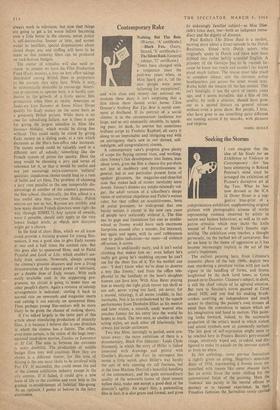Seeking the Storms
I CAN imagine that the idea of his Study for an Exhibition of Violence in • Contemporary Art has been simmering in Roland Picasso's disruptive art at the Tate. What he has
in Dover Street is a sug- arranged the exhibition of now devised at the ICA gestive blue-print of a comprehensive exhibition, supplementing original pictures with photographic screens of works representing violence observed by artists in nature and human behaviour, as well as its sub- jective stimulus which may incite the knife wound of Fontana or Davie's frenetic sign- writing. The exhibition even touches, a thought perversely, on the barbed wit of caricatures. But let me keep to the theme of aggression as it has become increasingly implicit in the act of the artist's implement.
The earliest painting here, from Cezanne's romantic phase of the late 1860s, depicts two men murdering a prostrate victim with just such vigour in the handling of forms, and drama heightened by the dark lurid tones, as Goya passed on to Daumier. Cizanne's subject, in short, is still the chief vehicle of its agitated emotion. But turn to Soutine's storm painted at Cdret about 1920, and you find his snaking brush- sirokes asserting an independence and much nearer to charting the painter's own stresses of mind than the convulsion in nature which set his imagination and hand in motion. This paint- ing looks forward, indeed, to the automatic projection of the artist's mood in which violent and sexual symbols now so commonly surface. The last gasp of self-expression might seem to be reached here in Francis Bacon's gory-crusted visage, intuitively wiped out, re-caked, and diS- figured to make its assault on the nervous system as from an abyss.
In this anthology, some pre-war Surrealism is rightly given an airing. Magritte's notorious Rape of 1934, representing a female torso en wreathed with tresses like some obscene face, has an erotic force the more chilling for the conventional finish of the painting. Here the q/iolence' lies purely in the mental affront to decency or to rational experience. In their Freudian fantasies the Surrealists rarely carried
aggression into the actual handling of materials, their diligent productions unnerving one partly through the nerveless style. It has been given to recent expressionists to identify the gestural mark with brutishness, frequently embodied in slabs and streaks of pigment in which the figure is wholly absorbed into the impulsive act of painting.
But our responses are becoming shock-proof. The eye accepts the abnormalities of defiant licence without surprise, simply because there is no strong counterbalancing movement in art which stands for order and harmony. Academic art is exhausted. Hard-edge geometry and con- struction, making minor deflections in the shuffling of basic forms, offers a sanctuary of retreat—certainly no real crusade against the prevailing excesses of violence. It follows that only some widespread classical revival (not in- conceivable) inspired by such stable and logical virtues as can place, say, Ldger's mechanics be- side Uccello's warriors, could give to irrational departures their proper significance. Like healthy government, any party in modern art needs a strong opposition in order to advance its aims with conviction, curbing the excesses of its lunatic fringe.
NEV1LE WALLIS



































 Previous page
Previous page